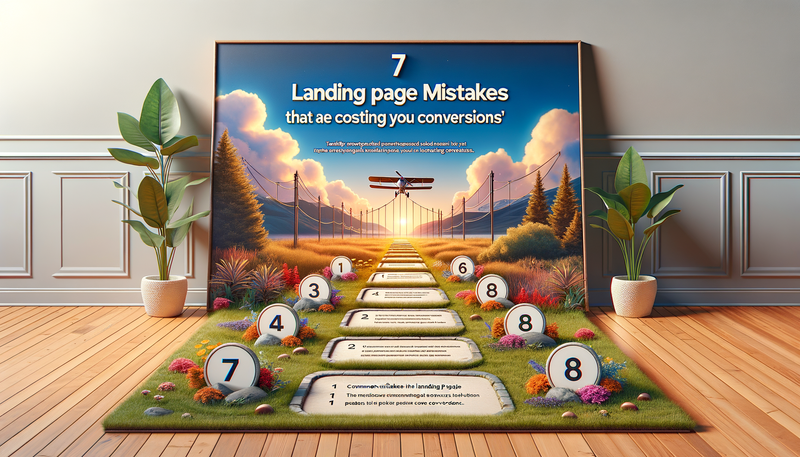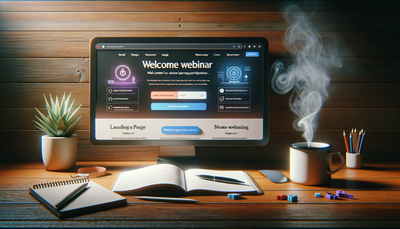7 Landing Page Mistakes That Are Costing You Conversions
Creating an effective landing page is crucial for converting visitors into customers. However, many businesses make common mistakes that can significantly impact their conversion rates. In this article, we'll explore seven landing page mistakes that could be costing you valuable conversions. By identifying these pitfalls and learning how to avoid them, you can optimize your landing pages for better performance and increased conversions. We'll cover issues ranging from unclear value propositions to poor mobile optimization, providing actionable insights to help you create landing pages that truly convert.Table of Contents:

1. Unclear Value Proposition
One of the most critical mistakes in landing page design is failing to clearly communicate your value proposition. Your value proposition should instantly convey what makes your product or service unique and why visitors should choose you over competitors.To avoid this mistake, ensure your headline and subheadline clearly state the benefits of your offering. Use concise, compelling language that resonates with your target audience. Consider A/B testing different value propositions to determine which one resonates best with your visitors and drives the highest conversion rates.
Do you need a website? Want to build a website but don't know where to start? Our website builder is the perfect solution. Easy to use, and with the ability to customize to fit your business needs, you can have a professional website in no time.
2. Cluttered Design and Information Overload
A cluttered landing page with too much information can overwhelm visitors and distract them from taking the desired action. This often leads to confusion and decreased conversion rates.To address this issue, focus on creating a clean, streamlined design that highlights your key message and call-to-action (CTA). Use whitespace effectively to guide the user's eye to important elements. Prioritize the most crucial information and remove any unnecessary content or design elements that don't directly contribute to your conversion goal.
3. Weak or Confusing Call-to-Action
Your call-to-action (CTA) is the gateway to conversion, and a weak or confusing CTA can significantly hurt your conversion rates. Common mistakes include using vague language, poor placement, or having multiple competing CTAs on a single page.To improve your CTA, use clear, action-oriented language that tells visitors exactly what will happen when they click. Make your CTA button stand out visually with contrasting colors and appropriate sizing. Place it prominently on the page, and consider using directional cues to draw attention to it. Limit the number of CTAs on a single page to avoid confusion and maintain focus on the primary conversion goal.
Building a website with SITE123 is easy
4. Lack of Social Proof
Failing to include social proof on your landing page can lead to decreased trust and lower conversion rates. Social proof helps build credibility and reassures visitors that others have had positive experiences with your product or service.Incorporate various forms of social proof on your landing page, such as customer testimonials, case studies, trust badges, and social media followers count. If you have impressive statistics or have worked with well-known clients, showcase these as well. Ensure that your social proof is relevant to your target audience and aligns with your value proposition.
5. Slow Page Load Speed
A slow-loading landing page can significantly impact your conversion rates, as visitors are likely to abandon the page if it takes too long to load. In today's fast-paced digital world, every second counts.To improve your page load speed, optimize images and videos, minimize the use of heavy scripts and plugins, and leverage browser caching. Consider using a content delivery network (CDN) to serve your content faster to visitors from different geographic locations. Regularly test your page speed using tools like Google PageSpeed Insights and make necessary optimizations to ensure your landing page loads quickly across all devices.
6. Poor Mobile Optimization
With an increasing number of users accessing websites on mobile devices, failing to optimize your landing page for mobile can result in a significant loss of conversions. A page that looks great on desktop may be difficult to navigate or read on smaller screens.Ensure your landing page is fully responsive and provides an excellent user experience across all device types. Use a mobile-first design approach, focusing on essential elements and streamlining content for smaller screens. Pay attention to font sizes, button placement, and overall layout to make it easy for mobile users to consume your content and take action.
7. Lack of A/B Testing
Not conducting regular A/B tests on your landing page elements is a missed opportunity to improve your conversion rates. Without testing, you're relying on assumptions rather than data-driven decisions.Implement a systematic A/B testing strategy for your landing pages. Test various elements such as headlines, CTAs, images, form fields, and page layouts. Use the insights gained from these tests to continuously refine and optimize your landing pages for better performance. Remember that A/B testing is an ongoing process, as user preferences and behaviors can change over time.





